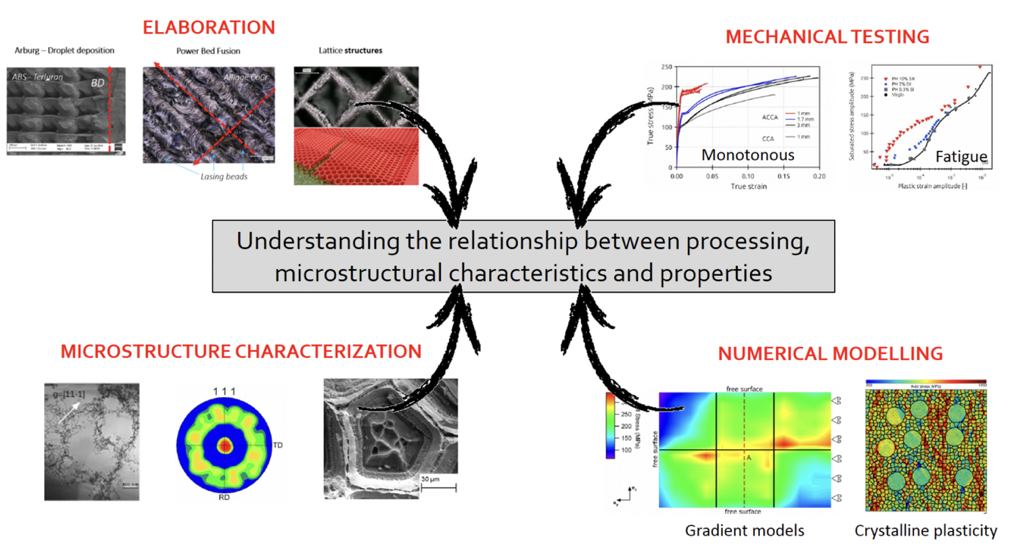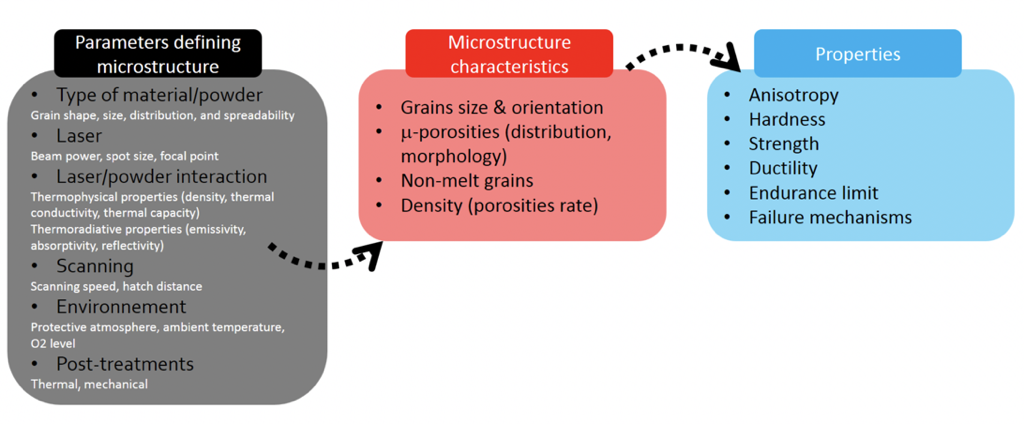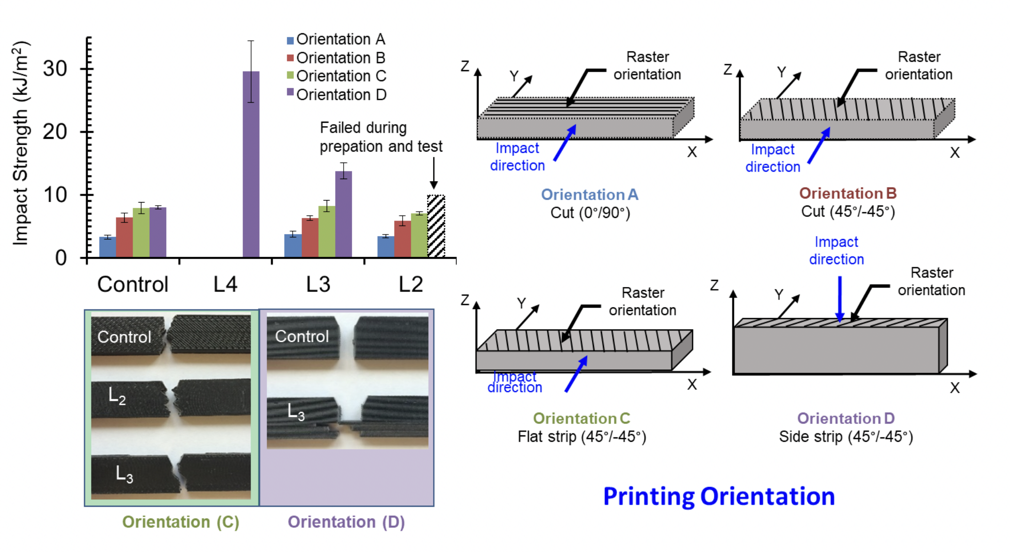1. Scientific strategy
The scientific strategy of the GPM implemented for AM is based on multi-scale and multiphysical approaches (Fig. 1) which aim to characterize and understand the deformation mechanisms and physical phenomena underlying the macroscopic observations, particularly under different types of loading (non-proportionality, cyclic, thermal-mechanical-metallurgical interactions, etc.).

2. Technical means
The GPM laboratory brings together a set of know-how and equipment of excellence dedicated to the physics and mechanics of materials which constitutes a strong originality in the national research landscape (Fig. 2). This specificity and singularity of the GPM are put at the service of fundamental and applied problems.

3. Scientific approach
The approach adopted applies to different types of materials (metals and polymers) and makes it possible, in particular, to study the correlation "processes - microstructures - mechanical properties" of metal parts obtained by FA (Fig. 3), in collaboration with a major national player in FA, the Volum-E company. Since 2019, two CIFRE theses associating the GPM and two regional companies (Analyses & Surfaces and Volum-E) are interested in these aspects in the case of 316L steels and aluminum alloys.

This laboratory dynamic is part of a rich regional environment (industrial and academic). On a national scale, the laboratory participates in the GDR FAM (Metals Additive Manufacturing). Within the framework of the AMME International Laboratory (Advanced Mechanics and Materials Engineering), the GPM has developed for several years a collaboration with the Lincoln University of Nebraska (USA) around the problems of hybrid polymer additive manufacturing.

4. Polymer-oriented AM activities (PAM)
The aim of the work carried out is to modify the interfaces between layers during FFF (Fused Filament Fabrication) manufacturing by means of mechanical surface treatment (shot-peening). These interface effects increase the anisotropy during the manufacture of polymer parts and create beneficial effects from a mechanical point of view, in particular an increase in the toughness of the samples (Fig. 4).
Using the laboratory's AF machines (FFF, Arburg Plastic Freeforming, stereolithography for polymers - SLM 100 for metals), it is possible to prepare specimens for characterization and to evaluate the influence of different manufacturing parameters in order to optimize certain mechanical properties [2]. It is also possible to fabricate lattice structures in order to analyse the links between cellular architecture and properties (Fig. 5).

5. Activités Fabrication Additive Métalliques (FAM)
To illustrate the work related to the Metal-oriented AM, a few examples of studies can be presented. The first example concerns the comparison of fracture mechanisms in nickel based superalloy parts made by conventional means (casting) or obtained by Powder Bed Melting (SLM). Small scale analyses can explain the origin of the increased toughness of FA materials, with the existence of larger-walled cups that help dissipate more mechanical energy during cracking (Fig. 6).

The second example presents analytical results that allow the characterization of microstructures from AF using the state-of-the-art skills and tools available in the laboratory [3]. In particular, the EBSD maps (Fig. 7a) allow us to study the texture and anisotropy of materials obtained from AF in order to correlate manufacturing parameters (laser power, speed and laser strategy), formation of specific microstructures (cf. melt Figs. 7b and 7c) resulting from strong temperature gradients specific to the process, and macroscopic mechanical properties. Fundamental information for designing and producing reliable and durable parts via FA [4].

6. Ongoing projects and prospects
Several projects have started in the last few years (SCAMPI - Solutions for the Design and Analysis of Materials with Innovative Properties, PFAN - Plateforme Normande de Fabrication Additive - GPM / Crismat collaboration and CLIP FAM - Characterization of the LIt of Powder Additive Metallic Fabrication, Normandy academic and industrial collaborative project). They will be consolidated by other future projects (NiChroFab 2020-2023, labex EMC3 funding, GPM - CRISMAT collaboration). This work focuses on two issues: (i) understanding the link between process, microstructure and mechanical properties and (ii) mechanical behaviour of lattice structures.
Finally, the collaboration with the University of Nebraska will be strengthened by developing a research axis aiming at developing and characterizing metallic materials with property gradients.
Contact : Benoit Vieille Benoit.Vieille@insa-rouen.fr - 33232959756
References
[1] H. Hadidi, B. Mailand, T. Sundermann, E. Johnson, G. Madireddy, M. Negahban, L. Delbreilh, M. Sealy, Low velocity impact of ABS after shot peening predefined layers during additive manufacturing, Procedia Manufacturing, 34, 2019, 594-602.
[2] H. Ramezani Dana, F. Barbe, L. Delbreilh, M. Ben Azzouna, A. Guillet, T. Breteau.Polymer additive manufacturing of ABS structure: influence of printing direction on mechanical properties. Journal of Manufacturing Processes 44:288-298, 2019.
[3] B. Vieille, C. Keller, M. Mokhtari, H. Briatta, T. Breteau, J. Nguejio, F. Barbe, M. Ben Azzouna, E. Baustert. Investigations on the fracture behavior of Inconel 718 superalloys obtained from cast and additive manufacturing processes. Submitted to Materials Science and Engineering, February 2020.
[4] C. Keller, M. Mokhtari, H. Briatta, B. Vieille, P. Bernard. Influence of a rescanning strategy with different laser powers on the microstructure and mechanical properties of Hastalloy X elaborated by powder bed fusion. To be submitted to Materials Science and Engineering.



